- Home
- Mercury
mercury
[+ links to: Battle on Mercury - Brightside Crossing - The Darkside of Mercury - Immortals of Mercury - Invasions from Mercury - Mercury Awaits - Old Mercury - Ray Cummings' Mercury - Reply re Mercury language myth influencing Valeddom - The Resurrection of Merrick Hardcastle - Valeddom - What to see on Mercury - Where the Nightlife Never Ends - Zookie Must Die ]

This is the planet that has suffered the most from space-age science.
Stid: I seem to recall you once said that about Mars.
Zendexor: Did I? Maybe I did. Both Mars and Mercury have taken a savage knock, as far as our romantic ideas about them are concerned...
Harlei: Come on, Stid, it's obvious what the Webmaster means. Sure, Mars lost a lot - lost its canals....
Stid: Not to mention its breathable atmosphere, its life...
Harlei: ...but Mercury lost even more! Lost the entire point of its existence. Namely, its spin.
Stid: You have an unfortunate way of putting things.
Zendexor: Face it, he's right. Spin, here, was a matter of life and death. That's to say, the life and death of an idea. Before the 1960s it used to be believed that the rotation of the innermost planet was tidally locked to the Sun.
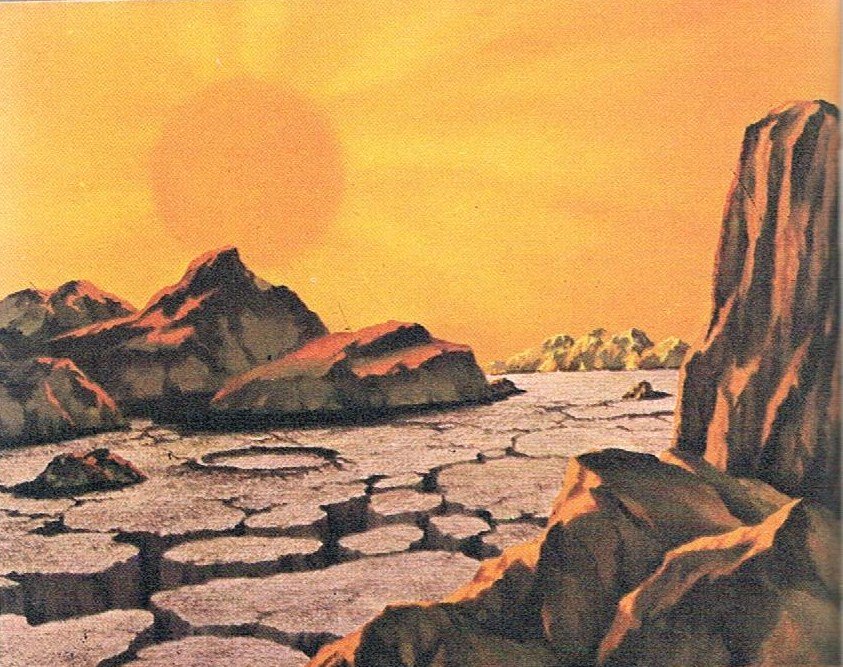
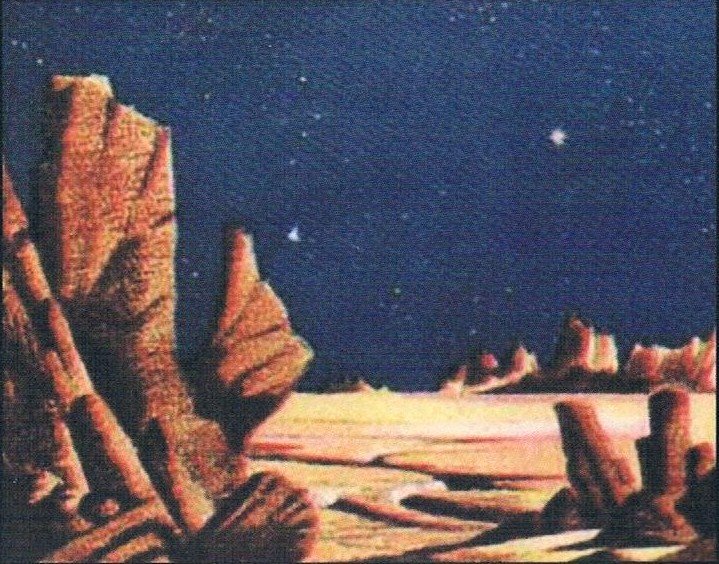
That meant the planet must always present the same face to the Sun, and the other side to frozen eternal Night, with a Twilight Belt in between. What more wonderful setting could there be for a poetic and thrilling planetary romance?
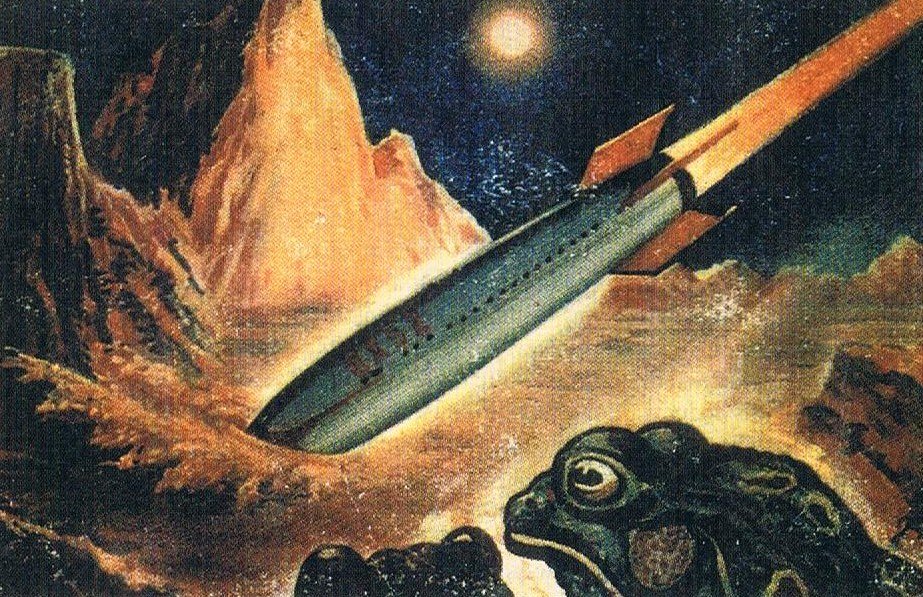
And now all that has been disproved by science. Mercury does rotate with respect to the Sun, albeit slowly (three of its days take up two of its years). So there can't be any permanent Dayside, Nightside or Twilight Belt. All gone. Wiped out by science.
Stid: Tough.
Harlei: But luckily that didn't happen until some great stories had been written.
Classics of the inmost planet
Harlei: Three tales in particular stick in my mind. One of them is Brightside Crossing. This is the definitive "harsh, inorganic, hellish-heat" tale - a stupendous epic of daring and endurance, compressed into 23 stunning pages. It's set on a parched, lifeless Mercury where human explorers pit themselves against the furnace of Dayside in an attempt to be the first to cross it.
We were moving down into desolation that made Earth's old Death Valley look like a Japanese rose garden. Huge sun-baked cracks opened up in the floor of the gorge, with black cliffs jutting up on either side; the air was filled with a barely visible yellowish mist of sulfur and sulfurous gases...
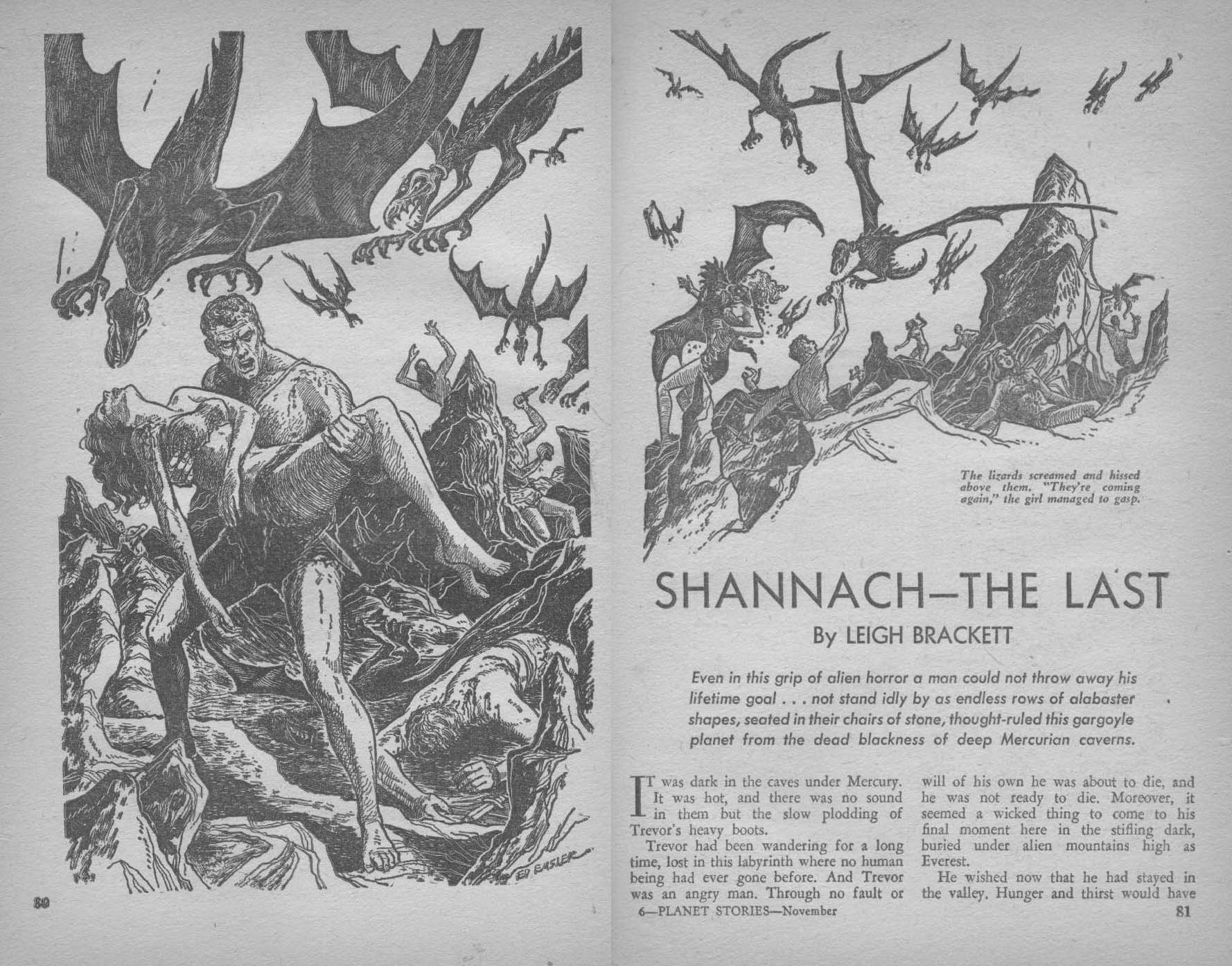
Then there is The Immortals of Mercury, in which a human explorer is trapped by an underground super-race of native savants. And thirdly we have Shannach - The Last, in which the survivor of an ancient silicon-based race lords it over a lost valley in the Twilight Belt.
Zendexor: Right, you've certainly picked the three Old Masters, Harlei. Anything else?
Harlei: What about The Demons of Darkside?
Zendexor: We'll save that for our page on The Darkside of Mercury. Demons is a relatively minor, though still interesting, cousin to Shannach. Any other tales dedicated to Mercurian adventure, which, while not being masterpieces, are fun enough to read?
mercurian travelogue
Harlei: Here's one: a 1940 magazine tale, Via Mercury. A cute travelogue: the journal of a space-pioneer on the first Mercury expedition. They land in the Twilight Belt but close to Sun-side, and at first fail to find life.
...We have our Sunward ports shuttered, otherwise we'd be blinded.
The view from our other ports shows a world not only utterly weird, but decidedly inhospitable - tumbled, flinty rock fields, a jagged mountain range off to the side, smooth lava plateaus. No signs of life, not even a tuft of moss or a single hardy cactus. Only rock, of a thousand varieties...
Eventually the expedition does find evidence of life. At first this isn't native life - though it's quite interesting: namely, pyramids built by ancient explorers from Mars who are now extinct but who preceded Terrestrial mankind in the exploration of the inner solar system.
Then on Day 59 they find the real stuff:
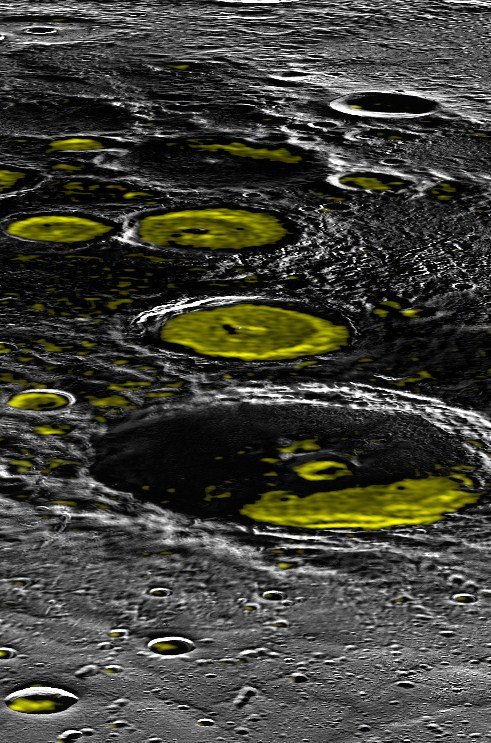
...Captain Atwell and his party cautiously descended the slope of the valley, guns ready. The lower they went, the more life appeared, from algae, to moss, to rudimentary ferns and clumps of bushes. Finally, toward the center ten miles long, grew a forest of reeds fully two hundred feet high. In Mercury's light gravity, the thin stems can support a tremendous height of foliage.
Swinnerton kept up a running fire of disjointed conjecture. Ages ago, Mercury rotated, he said, and supported a flowering life in what would correspond to our arctic and antarctic, here equatorial. When the rotation finally ceased, this withered away. Only a remnant survives now in the narrow strip of the Twilight Zone. Sunken valleys protect it from the blistering Day Side and from the deathly cold of the Night Side.
Swinnerton wondered how much of the animal life had survived. Watching and wandering, they saw. Insects buzzed about, amazingly large ones, the size of song birds. Birds, in turn, were all bigger than eagles, snapping up the huge insects as Earth birds snap up gnats. Mammals were winged. Flying wolflike creatures lumbered by, seeking prey in the universal rule of life.
One great bearlike creature, with a membranous wing spread of thirty feet, hovered over them as though contemplating attack. Then it flapped away grotesquely...
It was strange and pathetic. These monsters represented the last of a planet's evolution, bound to a tiny strip of territory...
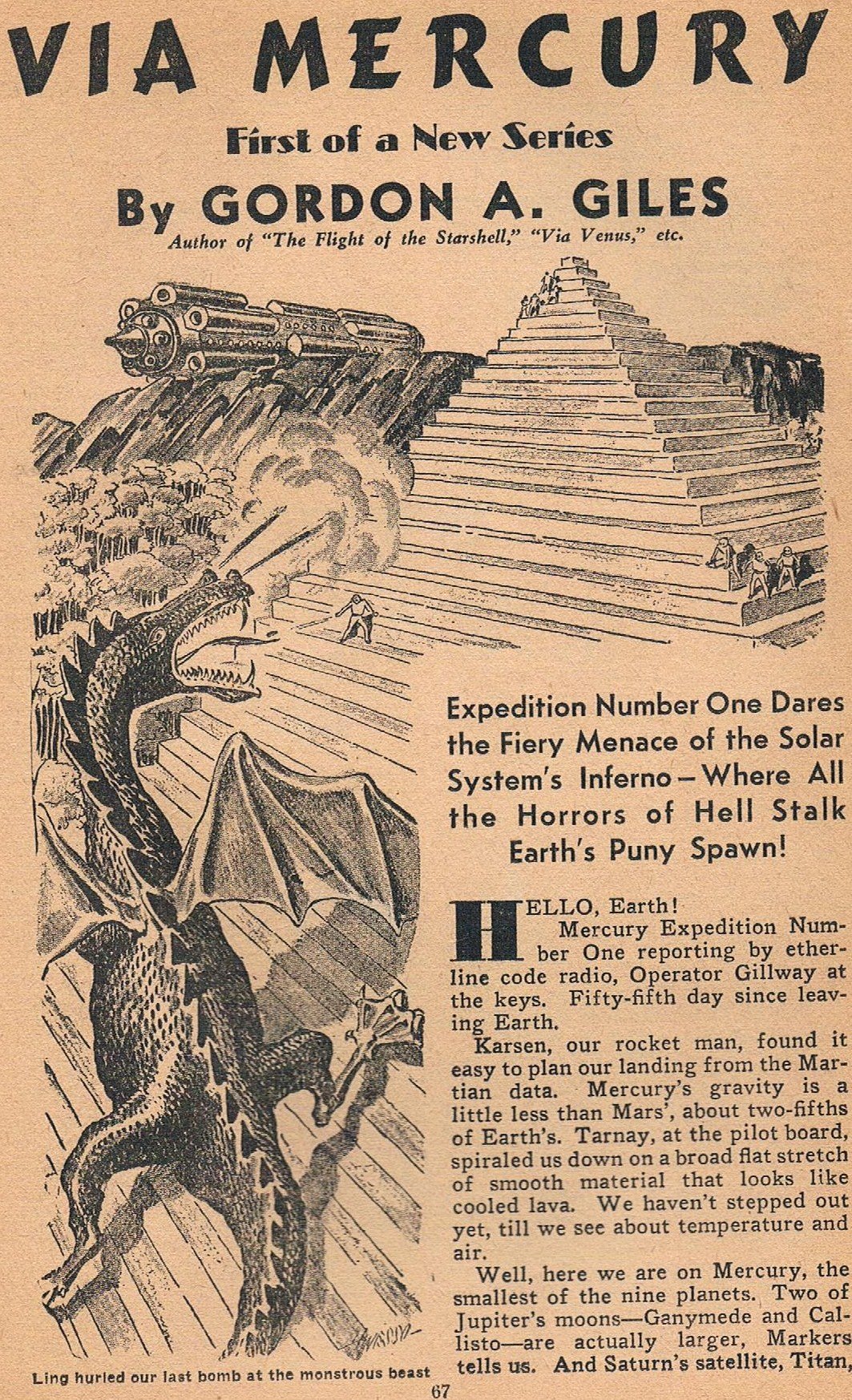
Stid: Almost seems a bit too crowded.
Zendexor: I know what you mean. Mercury - even OSS Mercury - can hardly be luxuriant, can it? On the other hand it does have a lot of solar energy to hand, if only life can evolve a way of converting it to its use...
Harlei: Aha, this is what rescues the story, which I admit was sailing rather close to unbelievability-in-its-own-terms. For later on we get a Hot-side silicon monster - a Mercurian embodyment of old myth, perhaps shown to prehistoric Earthlings by the ancient Martians...
Atwell, Swinerton and Ling saw something still more amazing, before they returned. In an open patch among the huge reeds, they suddenly came face to face with a truly monstrous creature. Scaly and winged, large as a dinosaur, it seemed curiously familiar. When a steamy breath came from its nostrils, Ling recognized it.
"It's a dragon!" he yelled. "Run!"
Ling himself ran. But Swinerton, paralyzed, just stared. When he did turn to run, he stumbled and fell. Captain Atwell stood over him as the monster charged, and pumped shots at it. It swerved, ran past them, gaining speed. It launched itself into the air. Ponderously it flapped its mighty wings. Rising like a great airplane, it soared out of the valley and turned toward the Sun.
Atwell and Swinerton watched, amazed. Their bullets had merely scared it away. And it vanished in the distance, over the Day Side. Did it live somewhere out in that inferno?
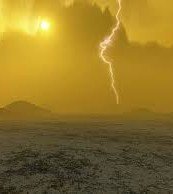
On their return, we speculated about this incredible creature. Swinerton displayed chips that the bullets had knocked off the scales. They were flinty horn, and Von Zell labeled them as silicic in composition.
Silicic life, Swinerton surmises from that - carbonaceous tissue, replaced by the analogous silicaceous tissue. He wildly assumes that it forages mainly out on the blazing Day Side, among other silicon life-forms. He pictures it waddling through pools of molten metal, perching on mountain-tops, exposed to incandescent heat...
Stid: What you might call straightforward archetypal stuff.
Harlei: Yes, well, I dare say Zendexor's allowing me to give all this space to a run-of-the-mill story because he knows there aren't many runs to this particular mill: I mean, apart from Via Mercury and the three masterpieces I mentioned earlier, I'm reduced to scrounging for scraps, like the one-line reference in The Shadow Out of Time to the "bulbous vegetable entities of Mercury"...
neo-oss mercury
Stid: And you'll have to keep rooting among those old scraps, for there won't be any more brand-new stuff.
Zendexor: That is where you are wrong. Valeddom - Mercury Awaits defiantly resurrects the old Twilight Belt version of the planet.
Stid: Sounds as though the author's science must be somewhat shaky!
Zendexor: Actually he makes it clear, he knows about the discoveries of the 1960s.
Stid: Pah! The book's a fake, then. An anachronistic pastiche.
Zendexor: Far from it. The plot gives up-to-date reasons for the way it contradicts what we think we know. And we can hope that there's more to come. More refusenik tales, I mean - that is, if other "retro" authors follow suit, as Brackett followed Burroughs...and as Stirling has followed Brackett...
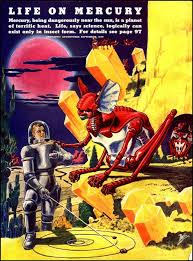
In other words we need more authors who are concerned to embody in narrative the colourful spirit of Frank R Paul's "Life on Mercury".
Bring life to the picture! - that ought to be the watch-word.
As indeed does happen for the fortunate narrator of Valeddom. He finds himself physically in a scene which he recognizes from a picture. For it turns out that, in literal truth, his path on Mercury has led him into a landscape which he had previously thought fictitious - known only from an artist's impression, an illustration in an encyclopaedia.
What happens to your mind when such a tatty old artist's impression - a faded, beloved picture of a bleak yet beautiful Mercurian landscape - perfectly matches, against all expectation, your real surroundings?
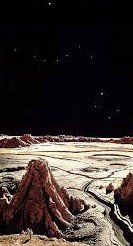 the Capian Plain, on Valeddom
the Capian Plain, on ValeddomBehind me, the others were dropping back, hesitating to follow. We were all hushed, but I was less subdued than they. Strange that I, the outsider, should feel suddenly the tremendous comfort and hope which lurked here - and which they did not share! But then, how could they know? No way could they know that I had just recognized the Capian Plain from the picture in the children's encyclopaedia in my house in England!
Here was that picture become reality. Here was the dark cracked plain under the purple-black sky, with pointy rocks framing the scene to right and left. Here, made real, was the tingling solitude whose beauty keeps you company forever. Here was the silence that speaks, when you can almost hear the ticking of Time's clock, the confident voice of the eventless years that flow past in their millions, saying, we have no need of happenings, our deadness is more alive than any flesh.
So I went forward. Without looking back, I crossed the invisible boundary between Yonnimay and Darkside, trustfully aware, as I did so, that I really had entered the scene from that beloved old book; that I trod the picture ground.
(For more on Valeddom, click here.)
serendipitous scraps
Harlei: Look, Stid's blowing out his cheeks again; before he explodes let's switch to an inventory of the earlier Mercurian tales, the ones he can't blame for having included the Twilight Belt - because they were written before the Belt was disproved.
Stid: Thought you said there were only scraps.
Harlei: Because they're only glancingly about Mercury. That is, Mercury isn't the main point of them. But they're still capable of giving out good stuff on that planet.
For example there's Out of the Sun...
Zendexor: Yes, that's a highly effective little piece, set in a Twilight Belt observatory. However, since the story's main point concerns an observation of solar life, let's reserve it for our page on the Sun.
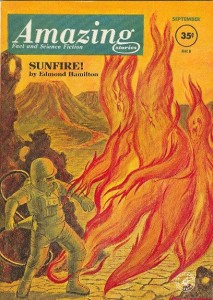
Harlei: And I suppose you'd raise the same objection against the flame beings in Sunfire! - they're not native Mercurians. Still, the story does provide a good (though short) visit to the hellish hotside of Mercury:
...There beat down upon them such a storm of radiation, such cataracts of heat and light, that instinctively they bowed their heads as before a deluge. It took an effort of will to step forward through that tempest, but Halfrich made it. They walked, slowly and heavily, and at first they saw only the blackened rocks beneath their feet, and the little puddles and rivulets of molten lead, and their own massive armored feet plodding.
Zendexor: Yes, I like that story, and would have liked it even better (to fit on this page) if it had then introduced us to some native Mercurians... There is the telepathic "heat leech" in Devil's World, but though that's a good enough story, it's short - and slight - and we don't actually get to see the critter...
Harlei: All right, what about the "harmonium" episode in The Sirens of Titan. Admittedly it's only a short part of the book, most of which is satire. But it sure does depict an unforgettable Mercurian life-form. Humble, but intriguing, it feeds off the rock-twang caused by the temperature extremes between Dayside and Nightside on their slowly vibrating, "singing" planet:
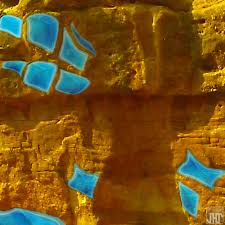
The creatures cling to the singing walls of their caves.
In that way, they eat the song of Mercury.
The caves of Mercury are cozily warm in their depths.
The walls of the caves in their depths are phosphorescent. They give off a jonquil-yellow light.
The creatures in the caves are translucent. When they cling to the walls, light from the phosphorescent walls comes right through them. The yellow light from the walls, however, is turned, when passed through the bodies of the creatures, to a vivid aquamarine.
The creatures in the caves look very much like small and spineless kites. They are diamond-shaped, a foot high and eight inches wide when fully mature...
Each creature has four feeble suction cups - one at each of its corners. These cups enable it to creep, something like a measuring worm, and to cling, and to feel out the places where the song of Mercury is best...
Though blind and indifferent to anyone's watching, they often arrange themselves so as to present a regular and dazzling pattern...
They are called harmoniums.
As I say, the book is satire, but not in this episode. The Mercury bit is pure joyous invention. (For more on Kurt Vonnegut's Mercury, click here.)
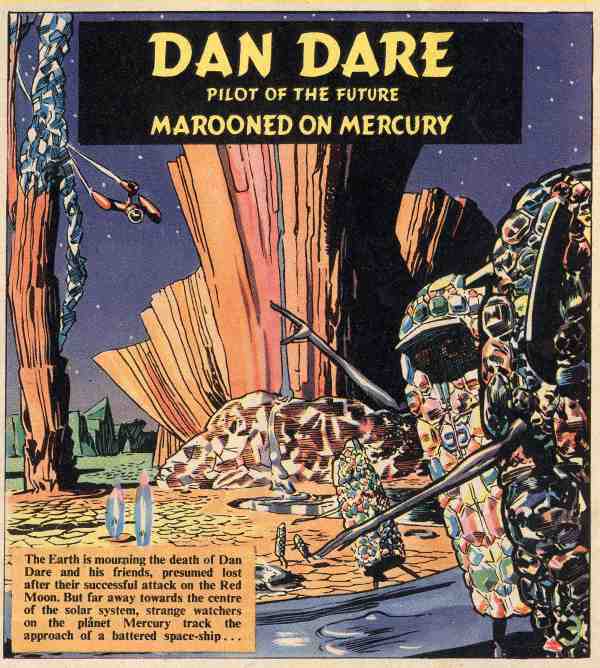
Zendexor: Here we touch upon a live wire running 'underground' between stories. Harmonium - harmony - music - the association of ideas gets us from The Sirens of Titan to the Dan Dare adventure Marooned on Mercury, where the Mercurian humanoids communicate with musical sounds!
Harlei: Humanoid Mercurians... We're creeping up the scale of life, back towards the Oumnis in The Immortals of Mercury, or Shannach...
Zendexor: Till we reach the very upper end of the scale: Viritrilbia!
Angels and science
Stid: You're both looking at me as though I ought to know "Viritrilbia".
Zendexor: Just assessing your general knowledge. Everyone ought to know That Hideous Strength, which though entirely set on Earth nevertheless contains an unforgettable episode in the chapter "The Descent of the Gods" in which the Intelligences governing the planets briefly touch our own world's surface - visiting the home of the Pendragon's secret successor.
At this gathering, Mercury, or Viritrilbia, appears in person - necessarily invisible, or near-invisible, but sensed by the mind and the emotions of the people present in the house. Downstairs:
...the party in the kitchen had made their ten o'clock tea. It was while they sat drinking it that the change occurred. Up till now they had instinctively been talking in subdued voices, as children talk in a room where their elders are busied about some august incomprehensible matter, a funeral, or the reading of a will. Now of a sudden they all began talking loudly at once, each, not contentiously but delightedly, interrupting the others. A stranger coming into the kitchen would have thought they were drunk, not soddenly but gaily drunk: would have seen heads bent close together, eyes dancing, an excited wealth of gesture. What they said, none of the party could ever afterwards remember... If not plays upon words, yet certainly plays upon thoughts, paradoxes, fancies, anecdotes, theories laughingly advanced, yet, on consideration, well worth taking seriously, had flowed from them and over them with dazzling prodigality... Mother Dimble always remembered Denniston and her husband as they had stood, one on each side of the fireplace, in a gay intellectual duel, each capping the other, each rising above the other, up and up, like birds or aeroplanes in combat. If only one could have remembered what they said! For never in her life had she heard such talk - such eloquence, such melody (song could have added nothing to it), such toppling structures of double meaning, such sky-rockets of metaphor and allusion.
Upstairs, meanwhile, the Intelligence appears more directly to the two adepts waiting in the Blue Room:
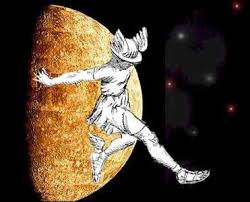
A rod of coloured light, whose colour no man can name or picture, darted between them: no more to see than that, but seeing was the least part of their experience. Quick agitation seized them: a kind of boiling and bubbling in mind and heart which shook their bodies also. It went to a rhythm of such fierce speed that they feared their sanity must be shaken into a thousand fragments. And then it seemed that this had actually happened. But it did not matter: for all the fragments - needle-pointed desires, brisk merriments, lynx-eyed thoughts - went rolling to and fro like glittering drops and reunited themselves....
All
fact was broken, splashed into cataracts, caught, turned inside out,
kneaded, slain, and reborn as meaning. For the lord of Meaning himself,
the herald, the messenger, the slayer of Argus, was with them: the
angel that spins nearest the Sun, Viritrilbia, whom men call Mercury and
Thoth.
If only that author had written a Mercury novel, what a corker it would have been.
Stid: You mention the planetary Intelligences in That Hideous Strength as "Gods" -
Zendexor: So-called because they must have given rise - faintly and indirectly - to the notions humans used to have of the old pagan gods. Actually, "guiding angel" describes them better.
Stid: Angels, gods, whatever - isn't this supposed to be science fiction? What are they doing here? Supernatural creatures...
Zendexor: Interestingly, the answer to that is, "Apparently not". C S Lewis, in his trilogy, appears to reserve supernatural attributes to God alone.

All the rest, including spiritual creatures such as angels and devils, he regards as, in principle, scientifically verifiable, incorporeal though they are.
But there is another objection you might make, and this Mercury page is as good a place as any to deal with it.
I refer to what you might call the "astrology connection".
Now, to anyone with a love of astronomy, astrology is sad stuff. Setting aside questions of plausibility for the moment, to regard the stars and planets as interesting because of their influences on our lives rather than for their own sakes is to demean them, make them boring and mundane.
Yet, as we saw in my comments regarding Vonnegut's "harmoniums" and Dan Dare, and as we read more explicitly in Lewis' passage on Viritrilbia, the old mythical connection between the god Hermes/Mercury and creativity has seeped into science fiction. Oh heck, you may say, astrology is influencing sf... that can't be right...
Fortunately, talk of influences can always be turned round. It can work the other way.
Suppose some real inter-dimensional seepage of character or essence, whereby some aspect of the real Mercury got entangled with myth and, via that, with science fiction...
It's part of the Grand Unified Literary Theory of Everything, that all stuff connects, and nothing is wasted.
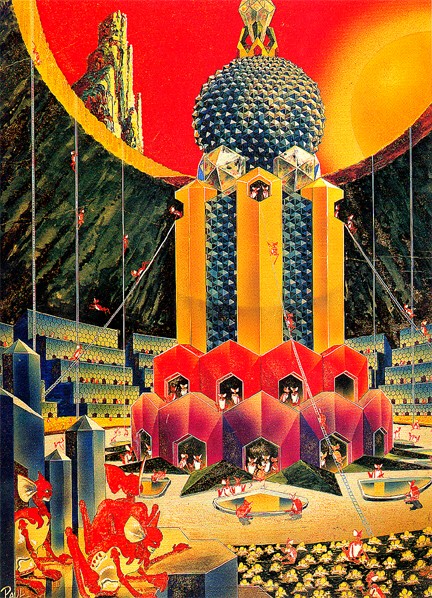 Quartz City of Mercury by Frank R Paul
Quartz City of Mercury by Frank R PaulLeigh Brackett, "The Demons of Darkside" (Startling Stories, January 1941); "Shannach - The Last" (Planet Stories, November 1952); Arthur C Clarke, "Out of the Sun" (1959); Randall Garrett, "Devil's World" (Imaginative Tales, July 1957); Robert Gibson, Valeddom - Mercury Awaits (2013); Gordon A Giles, "Via Mercury" (Thrilling Wonder Stories, October 1940); Edmond Hamilton, "Sunfire" (Amazing Stories, September 1962); Frank Hampson, Marooned on Mercury (Dan Dare comic strip in the Eagle, 1952-3); C S Lewis, That Hideous Strength (1945); Alan E Nourse, "Brightside Crossing" (Galaxy, January 1956); H P Lovecraft, "The Shadow Out of Time" (Astounding Stories, June 1936); Clark Ashton Smith, "The Immortals of Mercury" (1932); Kurt Vonnegut, The Sirens of Titan (1959)
For ancient Mercury, see the page on primordial worlds.
For the innermost planet's aggressive designs upon Earth, see invasions from Mercury.
For the literary problem posed by attempts to describe the extreme environment of the Mercurian day, see the page on Brightside Crossing.
For discussion of the possible reasons for Mercury's popularity on this site, see the OSS Diary for 23 July 2016.
See the OSS Diary, 17th September 2016, for Mercury, the Moon, and the Old Space Program.
For two accounts of far-out Mercurian life-forms, one on Nightside and the other on Dayside, see the OSS Diary for 26th December 2016.
For the unwise importation of Mercurian life-forms into a colony on the Moon, narrated by Arthur K Barnes in The Energy Eaters, see the OSS Diary, 19th January 2017.
For the colour of Mercury, see the OSS Diary, 9th February 2017.
For E. Antoniadi's 1934 map of Mercury, see the OSS Diary for 25th March 2017.
For the bargaining talents of Mercurians see the Diary, Bellyaching Spacemen.
See Mercury's Sun - Licence to Stretch for the size of that orb in the Mercurian sky. See also the same picture commented on in Exaggerating Mercury's Sun - 31 months later.
For a RSS echo of the Twilight Belt see The poles of Mercury.
For a brief, archetypal depiction of traditional Mercury in Gallun's Passport to Jupiter see Tantalisingly wrong for a Guess The World scene.
An inviting scenario is discussed in Norse Myth, Mercury and the Primordial OSS.
To expand your vocabulary see A Mercurian cuss-word and other matters.





































